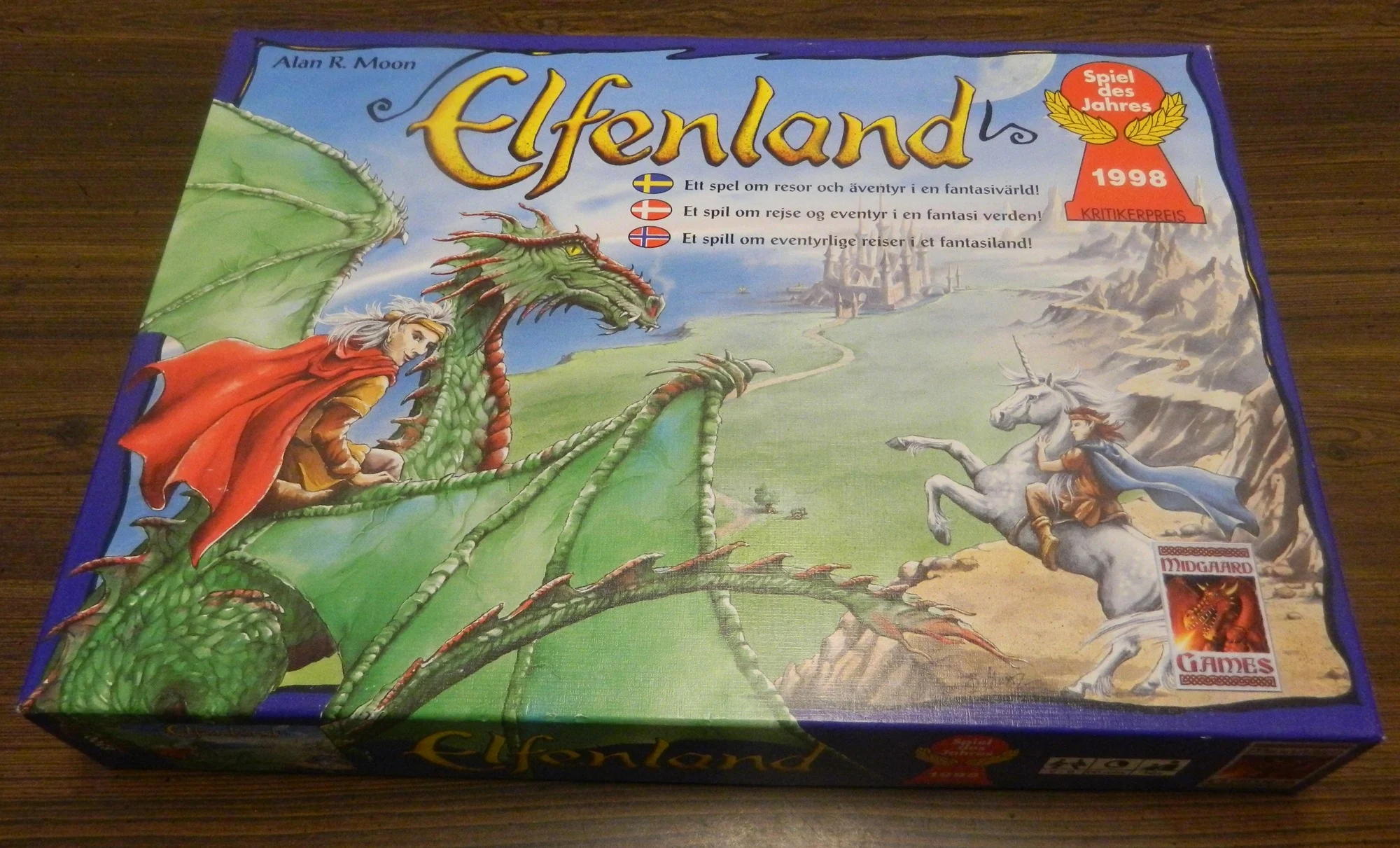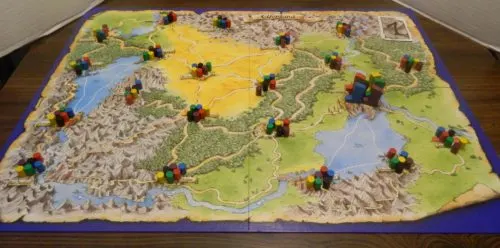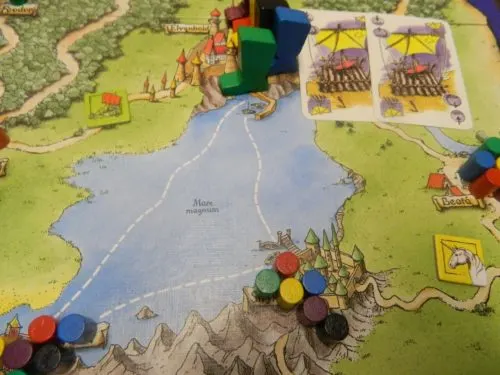Regular readers of this blog probably already know that my favorite board game of all time is the Ticket to Ride franchise (Ticket to Ride Europe Review) which was created by Alan Moon. While Alan Moon has created many good games, Ticket to Ride is easily his most famous board game which is well deserved. Although he has designed a lot of good games including several reviewed on this site (10 Days in Africa, 10 Days in the USA, Incan Gold, Skyline 3000, Walk the Dogs), Alan Moon has only won two Spiel De Jahres (Game of the Year) awards one for Ticket to Ride (2004) and the other for today’s game Elfenland (1998). Since it was designed by the designer of my favorite board game and won the game of the year award I had high expectations for Elfenland. While Elfenland is a good/great game, I still left a little disappointed with Elfenland.
How to Play Elfenland
Setup
Each player chooses a color and takes the boot and town pieces of their color. The boots are placed in Elvenhold and one town marker is placed in every town on the board. Each player also takes a transportation chart.
Separate the cards by the color of the back of the cards and shuffle each set of cards. If you aren’t using the advanced rule, place the cards with a green back into the box since they won’t be used. Place the travel cards next to the gameboard in one stack. Place the four round cards in the top right corner with the one card on top, followed by the two, and so on.
Separate the hazard tiles (red border) from the transportation tiles and give one hazard tile to every player. Place the transportation tiles face down on the table and mix them up. Draw five of the tiles randomly and turn them face up.
Give the starting player card to the oldest player who will start the game.
Playing the Game
The object of Elfenland is to visit as many of the towns on the board as possible within four rounds. Each round of the game has five phases:
- Deal Travel Cards
- Draw Transportation Tiles
- Play Transportation Tiles
- Move Your Playing Piece
- Cleanup
Dealing Travel Cards
In the first round of the game each player is dealt eight travel cards face down. In later rounds players are dealt enough cards to reach a total of eight cards in their hand. Travel cards are used during the movement phase. Each card indicates what type of travel it can be used for and also indicates on what types of terrain that form of transportation can be used on.

A player has been dealt these cards. This player is going to want to try and get tokens that match these forms of transportation.
Drawing Transportation Tiles
To begin this phase each player will draw a face down transportation tile which they will keep face down in front of them until they decide to use it. After everyone has drawn a face down tile, players will take turns drawing additional tiles. Starting with the first player each player can choose to either take one of the face up transportation tiles or one of the face down tiles. Whichever tile is chosen is placed face up in front of the player. If a face up tile is drawn, a new tile is turned face up to replace the tile that was taken. Each player will end up drawing three tiles in this fashion.
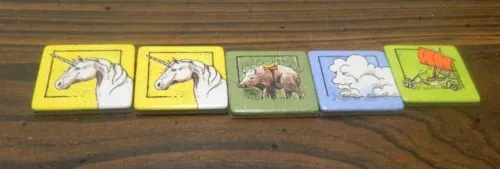
After every player has taken a face down tile, players can choose to either take one of the face up tiles or a face down tile.
Playing Transportation Tiles
Beginning with the first player, players will take turns playing tiles face up onto the gameboard on an unoccupied road (only one transportation tile can be played on each road). When placing transportation tokens, players need to reference their transportation chart or a card for that tile to verify what roads that tile can be played on. Players take turns playing one tile at a time.
Instead of playing a transportation tile, a player can choose to play their obstacle tile on top of a transportation tile that has already been played on the gameboard. By placing an obstacle tile, it requires players that are using that route to play an additional card in the movement phase. An obstacle tile can only be played in one round and is removed from the game at the end of the round.
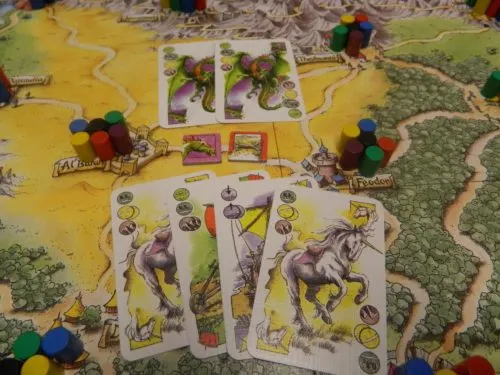
An obstacle has been placed on this dragon transportation tile. To use this route a player will have to use either two dragon cards or four other cards.
A player can choose to pass on playing a transportation tile on their turn but then play a transportation tile the next time play reaches them. If all of the player pass at the same time though the phase ends.
Moving
Starting with the first player each player will make all of their movements for the round. To move around the board a player has to play cards matching the forms of transportation on the roads they would like to use. The amount of cards needed to use a form of transportation is dependent on the type of road that it is placed on. Referencing the transportation chart or the cards they intend to play the player will have to play one or two cards to use a form of transportation. If a player would like to use a form of transportation but they don’t have the required cards, they can always choose to use a caravan. To use a caravan the player has to play three cards of any type. Players can use the same roads multiple times in their turn but must pay the cost each time they use it.
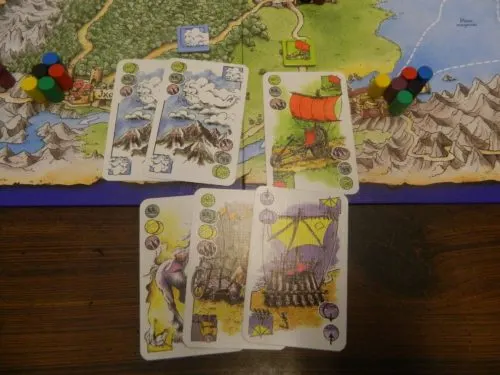
Two transportation tiles are shown on the gameboard. The Elfcycle was placed in a location where only one Elfcycle card needs to be played. The Magic Cloud has been played in an area where you need to play two Magic Cloud cards. If a player does not have the necessary cards for one of the two routes, they can use three of any type of card to use the route.
Whenever a player enters a town that they haven’t visited yet, they take their town marker from that town.
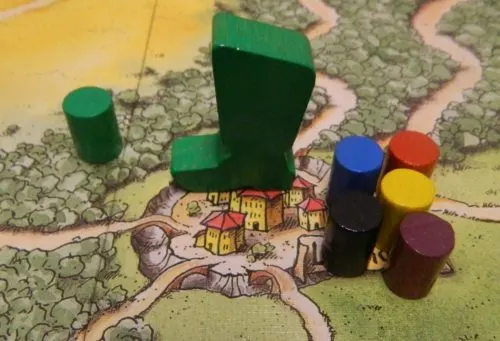
The green player has entered this town for the first time so they get to take their town marker from the town.
Moving on lakes and rivers have unique rules since their are no transportation tiles for these paths. When moving across a lake a player has to play two raft cards.
For rivers the player has to pay one raft card if they are moving in the direction of the arrow on the river. If they are moving in the opposite direction of the arrow, the player must play two raft cards.
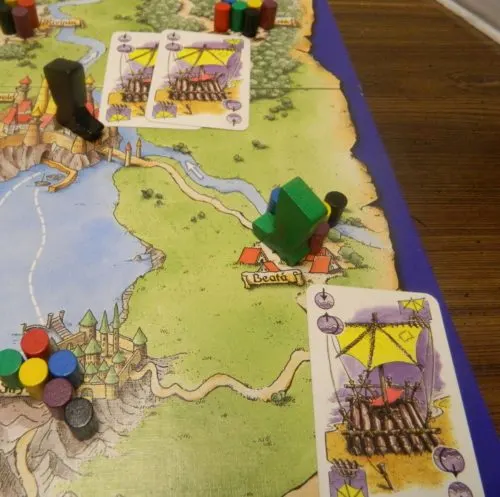
To move up river the green player will have to pay one raft card. The black player will have to use two raft cards to move downriver.
If a player wants to use a transportation tile that has a obstacle on it, the player has to play an additional card of the required type in order to use that tile.
Once the player has run out of cards or has chosen to stop moving, their turn ends. The next player then takes their turn. The phase ends when all of the players have moved their pieces.
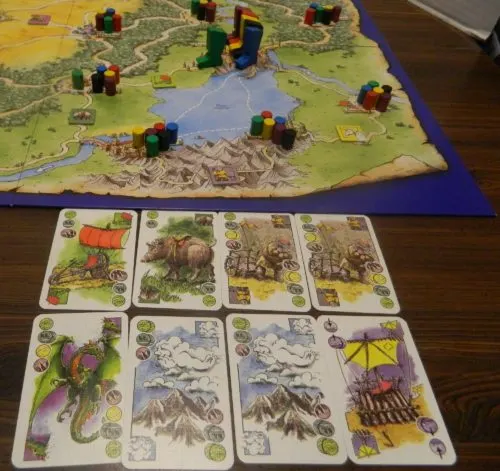
This player will begin their journey by using their elfcycle card to move left from the main city. The player will then use their giant pig card to move south. The player will use two troll wagon cards to move through the mountains. Since they don’t have a unicorn card they will use a dragon and two magic cloud cards to use that road. Finally the player will use a raft card to move back to the main city.
Clean Up
To prepare for the next round the following steps are taken:
- The top round card is put at the bottom of the round stack to indicate that the next round is about to begin.
- If a player has more than four cards in their hand, they must discard cards until they have only four cards left in their hand.
- Players have to turn in all of their transportation tiles except for one. If they keep their tile that was face down, it stays face down for the next round.
- Remove all of the transportation and obstacle tiles from the board. The obstacle tiles are removed from the game while the transportation tiles are placed back into the pile of face down tiles.
- The first player card is passed to the player to the left of the previous first player.
The players will then begin the next round. If this was the fourth round, final scoring is conducted.
End of Game
After the fourth round all of the players count up the town markers that they were able to collect throughout the game. If two of more players have the same number of town markers, the player with the most travel cards in their hand breaks the tie.
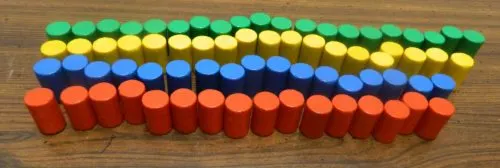
At the end of the game the green player has acquired the most town markers so they have won the game.
If a player is able to collect all of the town markers before the end of the third round, that player automatically wins the game.
Advanced Rule
If the players choose to use the advanced rule, each player will be dealt a town card at the beginning of the game. These town cards are kept secret from the other players until the end of the game. At the end of the game the players are trying to end their journey as close to the town on their card as they can. For each town away from their target town the player loses one of the town markers they gathered during the game. The player with the most town markers remaining wins the game.
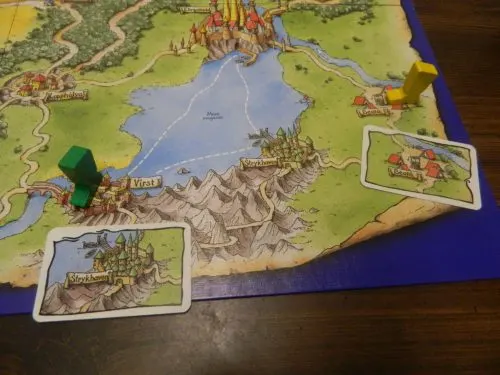
The yellow player has ended the game in their target town so they don’t lose any points. The green player is one town away from their target town so they will lose one point.
My Thoughts on Elfenland
While I was a little disappointed with Elfenland, I have to say most of that probably comes from the high expectations I had for the game. Being one of Alan Moon’s two game of the year winners, I was hoping that Elfenland would be able to reach the level of Ticket to Ride. Unfortunately it never reaches that level due to one issue that I will address later. Comparing Elfenland to Ticket to Ride was probably not a fair comparison since Elfenland was made almost a decade before Ticket to Ride. You can also tell that Ticket to Ride seems to have taken some inspiration for some of its’ mechanics from Elfenland.
Having played quite a few different Alan Moon games it didn’t surprise me that Elfenland is a pretty easy game to pick up and understand. I would say that it would take most people around 10-15 minutes to learn how to play the game. It might also take players a couple rounds to know exactly what they are trying to do in the game but once you get a hang of the game you should have no problems with it. While Elfenland is probably not going to work with young children, I think the game is accessible enough that children around the recommended age of ten shouldn’t have any problems with the game. As a whole I see Elfenland working quite well as a introductory game for these type of light to moderate strategy games.
While this isn’t a perfect comparison, at times Elfenland feels like a puzzle. At the beginning of each round you are dealt the cards that you are going to have to use in the current round. By looking at your cards you should have a decent idea of where you want to move on the board to maximize the cards that you were dealt. You then need to try and take tiles that work with your cards. You want tiles that match your cards but you also need to consider tiles that work well in the areas that you want to move through. Being able to use only one card to move to a lot of towns is crucial to winning the game.
Then there is the game’s cutthroat mechanic of placing tiles on the gameboard. I was actually surprised by the fact that Elfenland is considerably more cutthroat than I was expecting. This is one of the areas that actually reminds me of Ticket to Ride. Being able to claim a route and mess with the other players is key in both Elfenland and Ticket to Ride. You could have a perfect strategy for a round which maximizes your cards. Another player could then play a tile on one of the routes you wanted and ruin your strategy. Since only one tile can be played on each road you need to play your tiles to these crucial roads before another player can. A key to success in the game is figuring out where the other players are trying to go so you can claim the routes you need before they do.
Another area where Elfenland can be really cutthroat is when a player chooses to use their obstacle tile. Since an obstacle tile forces a player to pay an additional card to use a road, you could easily ruin a player’s strategy by making them waste cards getting past the obstacle instead of getting to another city. When planning their route a player may use routes that only require one card. If they now have to pay two cards they might not have enough cards of that type and thus will have to use four cards or use a different path. When used at the right time an obstacle can really hurt another player.
While Elfenland can be quite cutthroat there is also a very good reason to work with the other players. If two or more players are following the same path around the board, they could actually help one another. Since players can only have a max of four or five tiles in a round, players are capped at how many tiles they can play in a round. If two players actually work together (either directly or indirectly) both can benefit since they could lay out a longer route of transportation tiles. If both players have cards to use with these tiles they can both move further during a round. While these alliances are unlikely to last longer than a round or two, if you are able to move with another player you could actually mutually benefit from working with another player.
One of the most interesting mechanics in Elfenland is the idea of the town cards. While the mechanic is an alternative rule that you can choose not to use, I would recommend using it. It does add some luck to the game but I also think it adds strategy to the game. It is very important to either end in or near your target town since the penalty can be pretty large. This pretty much forces you to plan your route to move around the board in a way that you will reach your target city in the final round. Other players are obviously going to try and mess with you if they can figure out your target city so there is kind of a bluffing mechanic as you try to keep your town secret. While the target cities don’t work exactly the same, they kind of remind me of the route cards from Ticket to Ride.
I enjoyed my time with Elfenland and it is a pretty good game. Elfenland does rely quite a bit on luck though. I don’t mind luck as long as it feels like your actions still have an impact in the outcome of the game. Your actions definitely have an impact on your fate in Elfenland but I think luck plays too big of a role in the game. Luck comes into play in a couple different ways.
First the cards that you are dealt are going to determine what you can do on any given turn. Since there is no way to change what cards you are dealt, you basically need to figure out the best way to use them. If you are dealt a lot of cards that don’t work well with your current location, you are going to have a hard time moving to many towns on your turn. For example you could be in the desert areas and be dealt a bunch of cards that only work well in the mountains. You are then forced to pay the caravan price which will severely limit how many cities you can visit on a given turn. While I like that the caravan rules allow you to at least move a little on your turn, if you have to rely heavily on the caravans you are going to have a hard time winning the game.
The second area where luck comes into play is with the tiles you end up drawing. If none of the face up tiles work with the cards in your hand you are basically forced to draw a random tile hoping that you draw a tile that matches your cards. If you end up drawing a bunch of tiles that you don’t have matching cards for, you will have to use the caravan action or hope that other players play a tile that you can use.
This reliance on luck does not ruin the game but it does give you less control over the game than you would generally like to see from this type of game. While you can somewhat overcome bad luck in the game, if the players are equally skilled the luckiest player will likely win the game.
Other than the reliance on luck, the other problem with Elfenland is that it can have some pretty serious analysis paralysis issues. While the game doesn’t have a ton of decisions to make in any given round, there are still a lot of options to go through. If you play with players that must always try to find the absolute best move for each round, Elfenland can be a surprising long game. While it never gets too bad, the analysis paralysis issue can make Elfenland drag on a little longer than it probably should.
While doing some research for Elfenland I learned that the game has had an interesting development cycle. Back in 1992 Alan Moon published Elfenroads with White Wind, Inc. This version of the game was not widely published as Alan Moon couldn’t find a larger publisher for the game. Six years later he tweaked Elfenroads into Elfenland in order to simplify it to reach a more general audience. This worked as the game was widely published and ended up winning the Spiel Des Jahres. A year later the expansion Elfengold was published. Elfengold basically restored the mechanics removed from Elfenroads when it was turned into Elfenland.
While I haven’t played the game with Elfengold, I think it could really improve Elfenland. Elfengold basically adds a money element to the game which allows players to purchase transportation tiles on their turn. I think this expansion could really improve Elfenland because it probably eliminates a lot of the luck in Elfenland while also adding some additional strategy to the game. The problem is that Elfengold is pretty expensive at this time.
While Elfenland’s components might not stand up when compared with some of the board games produced today, for the late 1990s the game looks quite good. When board games stated taking off in the 2000s, the quality of board game components improved as well. While it doesn’t compare with some of the board games made today, it is really nice for a 1990s board game. I love the game’s wooden components even though I don’t know why you use a wooden shoe for your playing piece. The artwork is also pretty good.
Should You Buy Elfenland?
While I was a little disappointed with Elfenland, it is still a very good game. It just doesn’t reach the same levels as Ticket to Ride. For a 1990s Euro style game though it is a very good game. The game is pretty easy to pick up and play. There is a decent amount of strategy to the game as well. Elfenland should appeal to people who rarely play board games along with people who like light to moderate games. Unfortunately the game has a little too much reliance on luck which hurts the game but doesn’t ruin it.
If you are not a big fan of light-moderate strategy games or hate when luck can have a decent impact on the game, Elfenland may not be the game for you. If you like games that are easy to pick up and play and yet still have a decent amount of strategy I think you will enjoy Elfenland.
If you would like to purchase Elfenland you can find it online: Amazon, eBay

